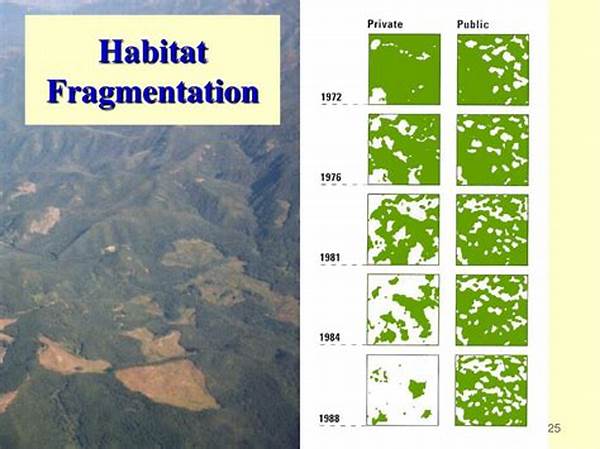The phenomenon of war-driven habitat fragmentation presents a growing challenge within the realm of environmental conservation. The destruction and division of ecological areas due to military conflict can have significant and lasting impacts on biodiversity and ecosystem functionality. As nations engage in warfare, the resulting environmental degradation often remains a less visible, yet pernicious consequence, severely affecting flora and fauna.
The Environmental Impact of Conflict
War-driven habitat fragmentation is a process whereby warfare activities, such as artillery bombardments, land mine deployments, and the construction of fortifications, lead to the disintegration of existing habitats. Such fragmentation can disrupt natural migration patterns, breeding grounds, and food chains. It also displaces local wildlife populations, leading to a decline in biodiversity. The ecological scars left by these actions take decades, if not centuries, to heal. Various species, especially those already endangered, find themselves in increasingly smaller and isolated patches, struggling to survive amidst fragmented and hostile terrains. Thus, the implications of war-driven habitat fragmentation extend beyond immediate human concerns, pervading into the very fabric of ecosystems that support life on earth.
Consequences of Fragmentation on Wildlife
1. War-driven habitat fragmentation disrupts wildlife corridors, isolating animal populations and preventing genetic exchange.
2. Critical habitats may become fragmented, leading to a decline in species populations reliant on specific environmental conditions.
3. Fragmentation increases edge effects, altering habitat conditions and impacting species adapted to interior habitats.
4. Warfare-induced fragmentation often leads to the creation of ecological traps, where attractive areas become unsustainable.
5. The resultant isolation of populations can lead to increased inbreeding, reducing genetic diversity and resilience.
Human Activities and Habitat Reduction
The interplay between warfare and environmental degradation vividly demonstrates the catastrophic effects of war-driven habitat fragmentation on land and ecosystems. As human activities, particularly warfare, intensify across various regions, natural landscapes endure unprecedented levels of destruction. The detonation of explosives and pollutants further exacerbates the problem by polluting the soil and water sources, rendering substantial areas inhospitable to both human and non-human life.
War-driven habitat fragmentation often results in the displacement of indigenous communities relying on natural resources for sustenance and cultural practices. As these habitats shrink and break apart, the traditional knowledge and practices that have preserved biodiversity for generations face the threat of extinction. Restoration efforts are profoundly challenging due to the sheer scale of destruction and the complexity of ecological networks disrupted in the process.
Mitigating Habitat Fragmentation
Mitigating the effects of war-driven habitat fragmentation requires concerted international efforts. Firstly, including environmental considerations in conflict resolution and post-conflict reconstruction can help prevent further ecological degradation. The establishment of peace parks and transboundary conservation areas can facilitate species migration and habitat connectivity. Additionally, restoring degraded lands through reforestation and habitat rehabilitation projects can promote ecosystem recovery.
Community involvement is crucial in these efforts, as local populations often bear the brunt of environmental and economic impacts brought about by war-driven habitat fragmentation. Therefore, integrating their knowledge and practices into restoration plans can yield sustainable outcomes. Policies must also aim at reducing the proliferation of unexploded ordnances and pollutants, thereby reducing their hazardous impacts on both habitats and human life.
The Role of International Organizations
International organizations play a pivotal role in addressing war-driven habitat fragmentation. They can facilitate cooperation between conflicting nations to ensure ecological considerations are part of peace agreements. Moreover, they can provide technical expertise and financial resources necessary for habitat restoration projects. By supporting research on the impacts of conflict on biodiversity, these entities contribute to a deeper understanding and awareness of the issue among global stakeholders.
The development of international treaties focusing on reducing environmental harm during wartime is another area where these organizations can exert influence. Such collaborative measures are essential for fostering a global commitment towards minimizing the environmental impact of conflict. Embedding environmental protection in international humanitarian law creates a legal framework encouraging nations to prioritize ecological preservation.
Challenges in Habitat Conservation
One of the significant challenges in addressing war-driven habitat fragmentation arises from the complexity of measuring and assessing ecological damage amidst ongoing conflicts. Data collection becomes dangerous and difficult, limiting the availability of accurate information necessary to prioritize conservation efforts. Moreover, resource allocation often favors immediate humanitarian needs over environmental rehabilitation, further complicating conservation endeavors.
Ensuring long-term commitment from all stakeholders in post-conflict scenarios poses another obstacle. Political instability and lack of funding can derail recovery initiatives, causing further deterioration of delicate ecosystems. It is imperative to address these challenges through strategic planning, enhanced international collaboration, and increased funding for conservation programs aimed at mitigating the detrimental impact of war on habitats.
Summary of War-Driven Habitat Fragmentation
In summary, war-driven habitat fragmentation presents a multifaceted threat to the conservation of global biodiversity. Armed conflicts not only devastate human communities but also leave indelible marks on the natural environment. Through habitat destruction and fragmentation, warfare disrupts ecological balance, leading to significant loss of species and degradation of ecosystems that sustain life. While the immediate focus of conflict resolution often addresses humanitarian needs, it is crucial not to overlook the environmental consequences.
The path to mitigating the impacts of war-driven habitat fragmentation involves a combination of forward-thinking policies, international cooperation, community engagement, and committed conservation efforts. By prioritizing the integration of environmental considerations in peace negotiations and reconstruction processes, societies can work toward healing both human and natural environments. Only through such comprehensive approaches can we address the profound and enduring challenges that war-driven habitat fragmentation poses to our planet.





